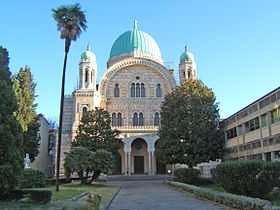History of the Jews in Florence: Difference between revisions
No edit summary |
|||
| Line 21: | Line 21: | ||
==Today== |
==Today== |
||
The Jews of Florence began to rebuild after the war. They repaired the Great Temple and established a home for Jewish seniors in 1957 and a Jewish school in 1964. In 2007, a local Jewish museum was opened. Today, the population of the Jewish community of Florence is over 1400, and there are now two synagogues for the city. |
|||
<ref> [http://www.jewishvirtuallibrary.org/jsource/vjw/Florence.html www.jewishvirtuallibrary.org] </ref> |
|||
==Great Temple of Florence== |
==Great Temple of Florence== |
||
Revision as of 01:35, 16 July 2011
| Part of a series on |
| Jews and Judaism |
|---|

The history of the Jews in Florence can be traced over seven hundred years. Florence (Template:Lang-it Template:IPA-it) is the capital city of the Italian region of Tuscany and of the province of Florence. The Jews of Florence have one of the oldest continuous Jewish communities in Europe. The historic Jewish community in Florence is one of the largest, and one of the most influential Jewish communities in Italy. The Jewish community in Florence also serves the smaller neighboring Jewish communities in Pisa, Livorno, and Siena.[1]
Medival history
Italian Jews fleeing persicution from southern Italy began to emigrate to Tuscan region by the begining of the 14th century. Many Jews who settled in Florence were merchants and bankers. In 1428, the small Jewish community in Florence lent funds to Pope Martin V in exchange for his protection for the local Jews. The Jewish community in Florence was formally founded in 1437. The Italian, Medici family of Florence was closely linked to the Jews of Florence. For instance, the Medici's protected the Jews of Florence from sermons by fanatical Roman Catholic clergy, such as Bernardino da Feltre and Girolama Savonarola who both pursued a policy of expulsion. However, when the Medici's fell briefly from power in the 1490's, the Jews of Florence were ordered to leave the city. Fortunately, Jewish money loaned to the republic of Florence delayed the expulsion until the Medici's returned to power in 1512. In 1537, a Sephardic Jew by the name of Jacob Abravanel from Ferrara was instrumental by influencing Cosimo de Medici in allowing Sephardic Jews and Marranos from Spain and Portugal to settle in Florence. Thus the growth of the Jewish community began to increase. In addition to Sephardic Jews, more Italian Jews from the Papal States also arrived. However, once Cosimo de Medici consolidated his power, he began to enact anti-Jewish laws such as special dress codes for the Jews. He also created the Jewish ghetto of Florence in 1571. Life in the Florence ghetto was compulsory for most of the Jews. However, within the ghetto, the Jews had a certain amount of legal and governmental autonomy. They established syngogues, schools, kosher markets, and ritual bath houses. By the 18th century, there were about a thousand Jews living the ghetto of Florence. [2]
Modern history
In 1799, emancipation came to the Jews of Florence from Napoleonic forces who occupied the city. In 1848, the ghetto was abolished and the Jews of Florence were given civil rights under a new constitution. By 1861, the Jews were given full citizenship and the ghetto was leveled to make room for urban renewal. In 1899, the Collegio Rabbinco Italiano (Rabbinical College of Padua) was relocated to Florence. Ashkenazi Rabbi, Samuel Hirsch Margulies became the principal of the college where he remained until his death in 1922. Rabbi Margulies was a strong Zionist and was very popular with the young Jews of Florence. [3]
Holocaust
By 1931, there were about 3,000 Jews living in Florence. Life was pleasant for the Jews of Florence and they represented in most segments of Italian society. However, with the outbreak of World War Two and the Nazi invasion of Italy, life for the Jews of Florence quickly deteriorated. In 1943, Florence was occupied by Nazi forces. The Nazis and their facist cohorts began to arrest and round up Jews. Deportation for the Jews began almost immediately and most Jewish families lost relatives. Dr. Rabbi Nathan Cassuto who was the Jewish communal leader was one of the first to be sent to Aushwitz. Of the 243 Jews deported, only 13 returned alive. However, many of the Jews of Florence escaped the Nazis by heroic Italians who hid the Jews during the Nazi occupation. In addition to the arrests and deportations, the Nazis both looted and vandalized Jewish property. For example, the Great Temple of Florence was damaged and nearly blown up by Germans. Most of it's great art was stolen. By the end of the war, the Jewish population was reduced to less than 1600. [4]
Today
The Jews of Florence began to rebuild after the war. They repaired the Great Temple and established a home for Jewish seniors in 1957 and a Jewish school in 1964. In 2007, a local Jewish museum was opened. Today, the population of the Jewish community of Florence is over 1400, and there are now two synagogues for the city. [5]
